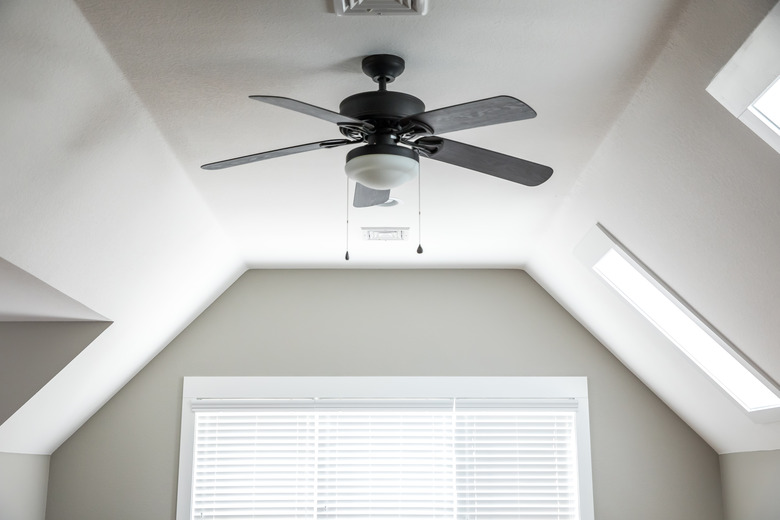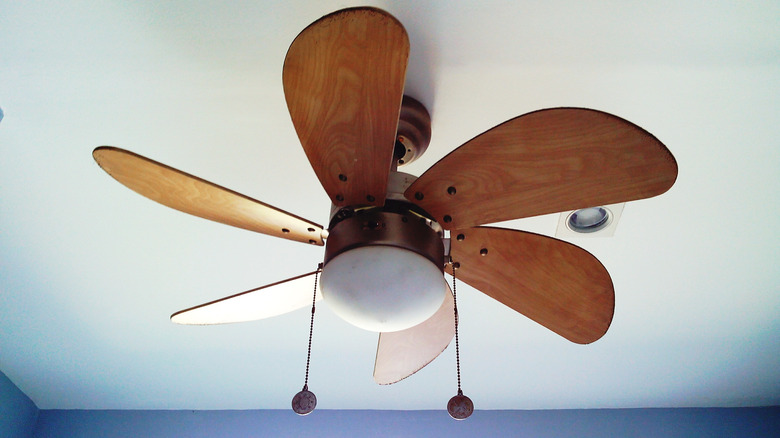How Much Energy Does A Ceiling Fan Use? (And Can Using One Cut Down On Cooling Costs?)
Ceiling fans circulate air around a room, providing a draft that makes the whole room feel more comfortable. Widely considered the most effective type of fan, the average ceiling fan wattage is 31.1, which means it will cost 11.5 cents to run it for 24 hours on average. Individual ceiling fans vary dramatically in energy efficiency, so it is wise to compare different models when purchasing one.
But how much energy does a ceiling fan use exactly? And, can running one in your home help you save money on energy costs? Here's what to know.
Understanding Ceiling Fan Wattage
Before you can figure out the energy consumption of ceiling fans, you must understand wattage, watt-hours, and kilowatt-hours (kWh). Wattage is the rate of electricity used when an appliance is running. To get the amount of electricity used, you have to add the factor of time.
A 50-watt ceiling fan running for 1 hour uses 50 watt-hours of electricity. The same fan running for 10 hours uses 500 watt-hours. For a more useful scale, energy companies base their charges on kWh, or 1,000 watt-hours (500 watt-hours is the same as 0.5 kWh).
To calculate how many kWh a fan uses, multiply the fan's wattage rating (which will vary by fan speed) by the hours you run it and then divide the result by 1,000. For example, a 40-watt ceiling fan operated for three hours would use 0.12 kWh:
- 40
x 3 = 120 watt-hours - 120/1,000 = 0.12 kWh
Ceiling fan packaging includes an Energy Guide label that states how much electricity the unit uses in watts by averaging the wattage it uses at its highest and lowest speeds when operated without light fixtures. Standard fan labels only provide statistics for the average use between the high and low settings. The most energy-efficient ceiling fans receive Energy Star certification. Energy Star labels also state the fan's wattage at its highest and lowest speeds and how many watts it uses while in standby mode (found on fans with a remote control). Some fan manufacturers voluntarily provide some or all of this information regardless of their Energy Star rating.
Calculating Ceiling Fan Usage Costs
You can use the average wattage on a fan's Energy Guide label to estimate how much it costs to run for a set period. If you want to learn how much power your current ceiling fan consumes, you can find its wattage on the label on top of the motor.
To determine your fan usage, simply multiply the kWh by the electricity rate to find the cost of running the fan. (Your electricity rate should be provided on your utility bill. If not, call your utility provider and ask.)
For the purposes of demonstration, you can use the national average rate, which is 15.42 cents per kWh as of June 2022, according to the U.S. Energy Information Administration (US EIA). The US EIA website lists the most current rates for individual states as well as for regions and the entire nation, but it's always best to find out your home's rate.
Often, it's easiest to calculate your cost of running a fan per hour. A 40-watt fan uses 0.04 kWh and costs 0.616 cents per hour to run at the national average electricity rate: 0.04 x 15.42 = 0.616. That's about six-tenths of a penny per hour. If you like to run the fan all night, say for 10 hours, it will cost 6.16 cents.
Note that each speed setting on a fan has a different wattage rating. A fan that uses 40 watts on the highest setting may use only 5 watts on the lowest. Consult the owner's manual or manufacturer for the wattage of each setting if it's not listed on the fan itself.
What About Airflow Efficiency?
Understanding a fan's energy efficiency doesn't stop with calculating how much energy it uses and how much it costs to run. A box fan or tower fan could use as much energy as a large ceiling fan, but these devices are less efficient than ceiling fans because it might take more than one of these fans to circulate as much air as the ceiling fan. When comparing different types of fans, you must also consider airflow efficiency.
Airflow efficiency is measured in terms of how many cubic feet per minute (CFM) air is circulated per watt of energy used. The higher the CFM, the more air moves around a room. The higher the CFM per watt, the more energy efficient the fan and the more it will help reduce your energy bills (compared to less efficient fans). To find this number, divide the CFM by the wattage of the fan:
- For example, a 21-watt fan that circulates 3,184 CFM provides 155 CFM per watt (3,184/21 = 151.6).
Luckily, you don't need to do this math yourself when shopping for new fans. Energy Guide labels detail how many watts the appliance uses, the airflow in CFM, and the overall airflow efficiency in CFM per watt.
Choosing the Right Ceiling Fan
Several factors have an impact on a fan's effectiveness and relative energy efficiency.
DC vs. AC Motor
When shopping for ceiling fans, look for an Energy Star model with a DC motor. An Energy Star ceiling fan will use 40 percent less power on average than comparable fans, and DC motors are 70 percent more energy efficient than AC motors.
For example, a Home Decorators Collection 68-inch Energy Star DC fan uses an average of 22 watts at 8,961 CFM, meaning it has an average efficiency of 407 CFM per watt. The total energy cost comes out to 8.14 cents per day ((22 x 24)/1000) x .1542), plus a small amount for the remote standby mode.
By comparison, a 68-inch AC fan that is not Energy Star rated uses an average of 61 watts at 5,508 CFM for an efficiency of 91 CFM per watt. With an operating expense of 22.57 cents per day ((61 x 24)/1000) x .1542), it costs nearly three times as much to operate this fan.
Fans work best when installed 10 to 12 inches from the ceiling, so hugger fans that flush-mount to the ceiling are less energy efficient than fans with a downrod. While an average 52-inch fan circulates 70 CFM per watt, an average hugger ceiling fan of the same size will only move 50 CFM per watt. It is best to ensure you have at least 6 feet 6 inches of clearance under a fan, though, which is why hugger fans are still the best option for homes with lower ceilings.
As for fan blades, long blades move more air than shorter blades, which is why ceiling fans use much less energy to circulate the same amount of air as table fans. Look for a model with the lengthiest blades appropriate for your room size, keeping in mind that a fan that's too large will overwhelm a small room. A fan up to 44 inches can cool a space up to 225 square feet in size, and fans 52 inches or larger can cool a large room up to 10 feet in diameter. For areas over 18 feet long, consider installing multiple fans. No matter the fan's size, make sure the blades are at least 18 inches away from any wall.
To understand how blade size translates to energy savings, consider that a 44-inch, Energy-Star-rated Minka-Aire fan uses 29 watts for an efficiency of 122 CFM per watt. While it may share many of the same specs as the Home Decorators Collection fan we featured above, the shorter blades move less air using 29 watts than the 68-inch blades do with only 22 watts.
Interestingly, it does not matter how many fan blades a model has, though the pitch of the blade does matter. Higher pitch translates to more effective air circulation, even when the fan blades move more slowly, so look for a model with an angle of at least 12 degrees or more. Don't focus exclusively on the pitch, though, because a fan with a high pitch and underpowered motor will still be less efficient than one with a low pitch and more powerful motor.
Does Using a Ceiling Fan Save You Money?
Yes, using a ceiling fan can save energy while cooling a house (and therefore money), to do so you need to use it correctly. Here are some tips:
- Only use it when you're in the room: The most important thing you can do to increase your fan's efficiency
is to turn it off when you leave the room. Ceiling fans don't cool the air; they just circulate it. As the air flows over your skin, it helps your body cool itself, making you more comfortable. Leaving a fan on when you're not in the room just wastes electricity. It also wears out the motor more
quickly and actually makes the room slightly warmer due to the motor generating heat. - Try to avoid a remote control fan: While a remote
control can make turning fans on and off easier, consider a smart ceiling fan if you have difficulty remembering to turn off your fan. This
type of smart home functionality allows you to control the device from anywhere
and set schedules to ensure you remember to turn off the fan when you leave for
work or go to bed. - Use your thermostat with your fan in a smart way: Don't forget to adjust your A/C unit accordingly. If
your ceiling fan makes you feel cooler, turn up your thermostat so your
energy-hogging air conditioning will turn on less frequently. A ceiling fan can
make your home feel cool enough to turn the thermostat up four degrees without compromising comfort. - Use your ceiling fan in all seasons. Many may not know you can use your fan for energy savings in the winter.
While fans should run in a counterclockwise motion during the summer to cool
the home, reversible fans can operate in a clockwise motion in the winter. When
the fan is set on a low speed in reverse, it sucks air up to the ceiling,
pushing the warm air near the ceiling down along the walls where it can reach
you. Using your ceiling fan this way can reduce your heating costs by as much
as 15 percent.





